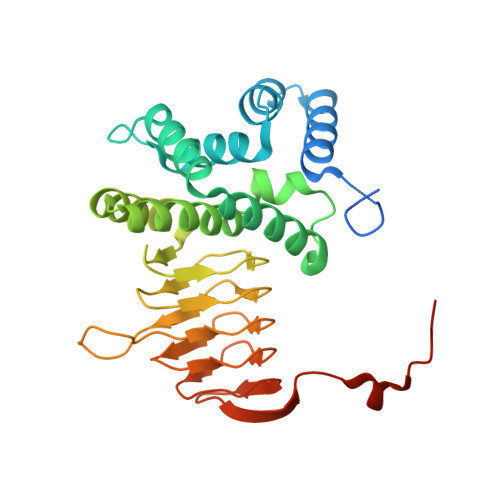Serine acetyltransferase from Neisseria gonorrhoeae; structural and biochemical basis of inhibition.
Oldham, K.E.A., Prentice, E.J., Summers, E.L., Hicks, J.L.(2022) Biochem J 479: 57-74
- PubMed: 34890451
- DOI: https://doi.org/10.1042/BCJ20210564
- Primary Citation of Related Structures:
6WYE, 7RA4 - PubMed Abstract:
Serine acetyltransferase (SAT) catalyzes the first step in the two-step pathway to synthesize l-cysteine in bacteria and plants. SAT synthesizes O-acetylserine from substrates l-serine and acetyl coenzyme A and is a key enzyme for regulating cellular cysteine levels by feedback inhibition of l-cysteine, and its involvement in the cysteine synthase complex. We have performed extensive structural and kinetic characterization of the SAT enzyme from the antibiotic-resistant pathogen Neisseria gonorrhoeae. Using X-ray crystallography, we have solved the structures of NgSAT with the non-natural ligand, l-malate (present in the crystallization screen) to 2.01 Å and with the natural substrate l-serine (2.80 Å) bound. Both structures are hexamers, with each monomer displaying the characteristic left-handed parallel β-helix domain of the acyltransferase superfamily of enzymes. Each structure displays both extended and closed conformations of the C-terminal tail. l-malate bound in the active site results in an interesting mix of open and closed active site conformations, exhibiting a structural change mimicking the conformation of cysteine (inhibitor) bound structures from other organisms. Kinetic characterization shows competitive inhibition of l-cysteine with substrates l-serine and acetyl coenzyme A. The SAT reaction represents a key point for the regulation of cysteine biosynthesis and controlling cellular sulfur due to feedback inhibition by l-cysteine and formation of the cysteine synthase complex. Data presented here provide the structural and mechanistic basis for inhibitor design and given this enzyme is not present in humans could be explored to combat the rise of extensively antimicrobial resistant N. gonorrhoeae.
Organizational Affiliation:
Te Aka Mātuatua School of Science, University of Waikato, Hamilton, New Zealand.
















